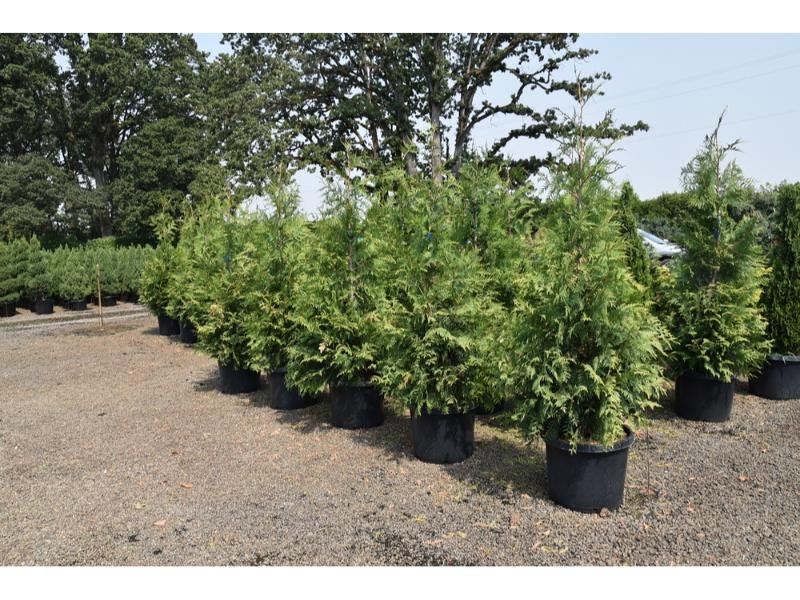The Thuja Green Giant, also known as Thuja standishii x plicata, is an evergreen coniferous tree valued for its rapid growth rate, tall height, and versatility in landscaping. This popular tree is a hybrid between the Japanese Thuja standishii and the Western Redcedar Thuja plicata.
Table of Contents
Overview of the Thuja Green Giant
The Thuja Green Giant is characterized by:
- Very rapid growth rate, capable of growing 5-7 feet per year
- Dense foliage on strong branches
- Narrow, pyramidal form with a rich green color
- Mature height of 60-80 feet tall
- Long lifespan of up to 250 years
This towering conifer is hardy in USDA zones 5-8 and tolerates a variety of soil conditions, including clay, sandy, loamy, or acidic soil. It can withstand drought, pollution, and exposure to salt.
Ideal Uses
- Windbreaks
- Privacy screens
- Noise barriers
- Security buffer
- Snow fences
- Erosion control
The Thuja Green Giant is popularly used for privacy screens, windbreaks, snow fences, security buffers, erosion control, and more given its rapid vertical growth and thick foliage. Its extensive root system also makes it useful for slope stabilization and preventing soil erosion.
The Root System of the Thuja Green Giant

Understanding the root system of the Thuja Green Giant is important when considering locations for planting this large tree.
Depth and Spread of Roots
The Thuja Green Giant develops a deep taproot descending 6-10 feet deep into the soil, with a network of wide-spreading lateral roots extending out twice the height of the tree.
For a mature 60-80 foot tall tree, some lateral roots may reach 120-160 feet away from the trunk. Most absorbing rootlets are in the top 18-24 inches of soil.
Root Structure and Morphology
The roots emerge from the tree as thick, woody structural roots that taper into smaller feeder roots. Structural roots provide support and stability, while feeder roots uptake water and nutrients.
Mycorrhizal fungi form symbiotic associations with the fine, hair-like rootlets of the tree, aiding the tree’s absorption of minerals and water.
Impacts on Nearby Structures
The extensive root system of mature Thuja Green Giants can potentially interrupt sewer lines, crack water pipes, or undermine the structural integrity of sidewalks or foundations if planted too close.
Recommended planting distance is 20-30 feet from any structures to prevent future root damage.
Before planting, call 811 to identify the locations of any underground utilities to avoid conflicts.
Ideal Soil Conditions
Thuja Green Giants can tolerate a wide variety of soil textures, pH levels, fertility, and moisture. The extensive root system allows the tree to seek out water and nutrients.
However, ideal soil conditions include:
- Well-drained soil – avoids root rot
- Moderate fertility – avoids excessive growth
- Slightly acidic pH of 6.0-7.0
Improving the soil with compost or fertilizer at the time of planting will encourage faster establishment.
Selecting Planting Locations

When selecting planting sites for the towering Thuja Green Giant, consider:
Sun Exposure
Thuja Green Giants grow best in full sun locations, receiving at least 6 hours of direct sun per day. Insufficient light leads to a thin canopy and reduced performance.
Wind Tolerance
The extensive root system and tapered form allow the tree to withstand high wind loads without breakage. It’s an excellent choice for windbreaks.
Planting Density
Allow 15-30 feet between mature specimen trees depending on the intended purpose. Closer spacing creates a dense, lush privacy screen.
For use as a windbreak, allow at least 15 feet between trees.
Proximity to Structures & Utilities
Plant the Thuja Green Giant at least 20-30 feet from buildings, pools, or other structures to prevent future root interference. Call 811 before planting to avoid underground utility lines.
Slope Stabilization
The wide-spreading root system is excellent at stabilizing steep slopes and controlling erosion. Use Thuja Green Giant to secure soil on embankments or around water features.
Planting and Care of the Thuja Green Giant
Proper planting and care promote rapid growth and establishment.
Preparing the Planting Site
Before planting:
- Conduct a soil test to determine any amendments needed
- Till the soil to a depth of 18-24 inches
- Incorporate compost or fertilizer as needed
- Identify locations of utilities by calling 811
Planting Steps
When planting, follow these guidelines:
- Dig a hole 2-3x wider than the root ball
- Score root ball sides with a knife
- Position so the top of the root ball is level with the soil surface
- Backfill the hole with native soil, tamping periodically
- Water thoroughly until soaked
- Apply 2-4″ organic mulch around the base
Ongoing Care
To encourage vigorous growth:
- Water deeply once a week during the first year
- Apply a balanced, slow-release fertilizer annually
- Reapply mulch as needed
- Prune only to control height/spread
Proper siting, planting techniques, and care will allow your Thuja Green Giant to rapidly grow into a beautiful evergreen tree for privacy, wind protection, noise barriers, or simple ornamentation. Enjoy this versatile, towering specimen conifer!

Gardening is my passion and growing plants indoors has always been a stress relief for me. Grow a banana tree in my apartment once (although failed to produce bananas).






